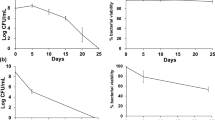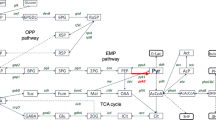Abstract
In the present work, a second gene encoding protein disulfide isomerase (PDI2) was cloned and characterized from Schizosaccharomyces pombe, and its regulation was studied. The structural gene encoding PDI2 was amplified from the genomic DNA using PCR, and ligated into the E. coli-yeast shuttle vector pRS316 to generate the recombinant plasmid pYPDI2. The determined DNA sequence carries 2,578 bp and is able to encode a protein of 726 amino acid sequence with CGAC at the putative active site. The fission yeast cells harboring pYPDI2 contained 1.62- and 2.73-fold higher PDI activity than the control yeast cells in exponential and stationary phases, respectively, indicating that the cloned gene is in vivo functioning. The PDI2 mRNA levels in both vector control and pYPDI2-containing yeast cells were found to be significantly higher in the stationary phase than in the exponential phase, suggesting that expression of the PDI2 gene is under stationary control. The yeast cells harboring pYPDI2 showed enhanced survival on minimal media plates containing nitric oxide (NO)-generating sodium nitroprusside (SNP) and no nitrogen. The synthesis of β-galactosidase from the PDI2-lacZ fusion gene was markedly enhanced in the Pap1-positive KP1 cells by SNP and nitrogen starvation. However, the enhancement in the synthesis of β-galactosidase from the PDI2-lacZ fusion gene by SNP and nitrogen starvation appeared to be relatively reduced in the Pap1-negative TP108-3C cells than in the Pap1-positive KP1 cells. The PDI2 mRNA level was elevated by SNP and nitrogen starvation in the Pap1-positive cells but not in the Pap1-negative cells. In brief, the S. pombe PDI2 plays a protective role against nitrosative and nutritional stresses, and is positively regulated by NO and nitrogen starvation in a Pap1-dependent manner.







Similar content being viewed by others
Abbreviations
- NO:
-
Nitric oxide
- ONPG:
-
ο-Nitrophenyl-β-d-galactopyranoside
- PCR:
-
Polymerase chain reaction
- PDI:
-
Protein disulfide isomerase
- RT–PCR:
-
Reverse transcriptase-polymerase chain reaction
- SNP:
-
Sodium nitroprusside
- S. pombe :
-
Schizosaccharomyces pombe
References
Gilbert HF (1997) Protein disulfide isomerase and assisted protein folding. J Biol Chem 272:29399–29402
Wilkins B, Gilbert HF (2004) Protein disulfide isomerase. Biochem Biophys Res Commun 1699:35–44
Tian G, Kober FX, Lewandrowski U, Sickmann A, Lennarz WJ, Schindelin H (2008) The catalytic activity of protein-disulfide isomerase requires a conformationally flexible molecule. J Biol Chem 283:33630–33640
Reinhardt C, von Brühl ML, Manukyan D, Grahl L, Lorenz M, Altmann B, Dlugai S, Hess S, Konrad I, Orschiedt L, Mackman N, Ruddock L, Massberg S, Engelmann B (2008) Protein disulfide isomerase acts as an injury response signal that enhances fibrin generation via tissue factor activation. J Clin Investig 118:1110–1122
Lu DP, Christopher DA (2008) Endoplasmic reticulum stress activates the expression of a sub-group of protein disulfide isomerase genes and AtbZIP60 modulates the response in Arabidopsis thaliana. Mol Genet Genomics 280:199–210
Zhang H, He J, Ji Y, Kato A, Song Y (2008) The effect of calnexin deletion on the expression level of PDI in Saccharomyces cerevisiae under heat stress conditions. Cell Mol Biol Lett 13:38–48
Updike MS, Sawdy JC, Wang LS, Liu S, Huang YW, Ye W, Farrar WB, Lin YC, Wick M (2007) Primary cultured human breast epithelial cell up-regulate protein disulfide isomerase in response to zeranol. Anticancer Res 27:407–410
Tanaka S, Uehara T, Nomura Y (2000) Up-regulation of protein-disulfide isomerase in response to hypoxia/brain ischemia and its protective effect against apoptotic cell death. J Biol Chem 275:10388–10393
Sørensen BS, Horsman MR, Vorum H, Honoré B, Overgaard J, Alsner J (2009) Proteins upregulated by mild and severe hypoxia in squamous cell carcinomas in vitro identified by proteomics. Radiother Oncol 92:443–449
Saloheimo M, Lund M, Penttilä ME (1999) The protein disulfide isomerase gene of the fungus Trichoderma reesei is induced by endoplasmic reticulum stress and regulated by the carbon source. Mol Gen Genet 262:35–45
Jeenes DJ, Pfaller R, Archer DB (1997) Isolation and characterization of a novel stress-inducible PDI-family gene from Aspergillus niger. Gene 193:151–156
Goecke M, Gallant C, Suntharalingam P, Martin NL (2002) Salmonella typhimurium DsbA is growth-phase regulated. FEMS Microbiol Lett 206:229–234
Kim SJ, Choi YS, Kim HG, Park EH, Lim CJ (2006) Cloning, characterization and regulation of a protein disulfide isomerase from the fission yeast Schizosaccharomyces pombe. Mol Biol Rep 33:187–196
Myers AM, Tzagoloff A, Kinney DM, Lusty CJ (1986) Yeast shuttle and integrative vectors with multiple cloning sites suitable for construction of lacZ fusions. Gene 45:299–310
Morjana NA, Gilbert HF (1991) Effect of protein and peptide inhibitors on the activity of protein disulfide isomerase. Biochemistry 30:4985–4990
Guarente L (1983) Yeast promoters and lacZ fusions designed to study expression of cloned genes in yeast. Methods Enzymol 101:181–191
Bradford MM (1976) A rapid and sensitive method for the quantitation of microgram quantities of protein utilizing the principle of protein-dye binding. Anal Biochem 72:248–254
Lee YY, Kim SJ, Park EH, Lim CJ (2003) Glutathione content and the activities of glutathione synthesizing enzymes in fission yeast are modulated by oxidative stress. J Microbiol 41:248–251
Nguyen AN, Lee A, Place W, Shiozaki K (2000) Multistep phosphorelay proteins transmit oxidative stress signals to the fission yeast stress-activated protein kinase. Mol Biol Cell 11:1169–1181
Toone WM, Kuge S, Samuels M, Morgan BA, Toda T, Jones N (1998) Regulation of the fission yeast transcription factor Pap1 by oxidative stress: requirement for the nuclear export factor Crm1 (exportin) and the stress-activated MAP kinase Sty1/Spc1. Genes Dev 12:1453–1463
Günther R, Brauer C, Janetzky B, Forster HH, Ehbrecht IM, Lehle L, Küntzel H (1991) The Saccharomyces cerevisiae TRG1 gene is essential for growth and encodes a lumenal endoplasmic reticulum glycoprotein involved in the maturation of vesicular carboxypeptidase. J Biol Chem 266:24557–24563
Tachibana C, Stevens TH (1992) The yeast EUG1 gene encodes an endoplasmic reticulum protein that is functionally related to protein disulfide isomerase. Mol Cell Biol 12:4601–4611
Tachikawa H, Takeuchi Y, Funahashi W, Miura T, Gao XD, Fujimoto D, Mizunaga T, Onodera K (1995) Isolation and characterization of a yeast gene, MPD1, the overexpression of which suppresses inviability caused by protein disulfide isomerase depletion. FEBS Lett 369:212–216
Tachikawa H, Funahashi W, Takeuchi Y, Nakanishi H, Nishihara R, Katoh S, Gao XD, Mizunaga T, Fujimoto D (1997) Overproduction of Mpd2p suppresses the lethality of protein disulfide isomerase depletion in a CXXC sequence dependent manner. Biochem Biophys Res Commun 239:710–714
Liao M, Hatta T, Umemiya R, Huang P, Jia H, Gong H, Zhou J, Nishikawa Y, Xuan X, Fujisaki K (2007) Identification of three protein disulfide isomerase members from Haemaphysalis longicornis tick. Insect Biochem Mol Biol 37:641–654
Hong BX, Soong L (2008) Identification and enzymatic activities of four protein disulfide isomerase (PDI) isoforms of Leishmania amazonensis. Parasitol Res 102:437–446
Sarver A, DeRisi J (2005) Fzf1p regulates an inducible response to nitrosative stress in Saccharomyces cerevisiae. Mol Biol Cell 16:4781–4791
Foster MW, Liu L, Zeng M, Hess DT, Stamler JS (2009) A genetic analysis of nitrosative stress. Biochemistry 48:792–799
Nakamura T, Lipton SA (2007) Molecular mechanism of nitrosative stress-mediated protein misfolding in neurodegenerative diseases. Cell Mol Life Sci 64:1609–1620
Uehara T (2007) Accumulation of misfolded protein through nitrosative stress linked to neurodegenerative disorders. Antioxid Redox Signal 9:597–601
Niwa T (2007) Protein glutathionylation and oxidative stress. J Chromatogr 855:59–65
Bell SE, Shah CM, Gordge MP (2007) Protein disulfide-isomerase mediates delivery of nitric oxide redox derivatives into platelets. Biochem J 403:283–288
Hromatka BS, Noble SM, Johnson AD (2005) Transcriptional response of Candida albicans to nitric oxide and the role of the YHB1 gene in nitrosative stress and virulence. Mol Biol Cell 16:4814–4826
Chiranand W, McLeod I, Zhou H, Lynn JJ, Vega LA, Myers H, Yates JR III, Lorenz MC, Gustin MC (2008) CTA4 transcription factor mediates induction of nitrosative stress response in Candida albicans. Eukaryot Cell 7:268–278
Kim SJ, Park EH, Lim CJ (2004) Stress-dependent regulation of the gene encoding γ-glutamyl cysteine synthetase from the fission yeast. Mol Biol Rep 31:23–30
Sahoo R, Dutta T, Das A, Ray SS, Sengupta R, Ghosh S (2006) Effect of nitrosative stress on Schizosaccharomyces pombe: inactivation of glutathione reductase by peroxinitrite. Free Radic Biol Med 40:625–631
Hiesinger M, Roth S, Meissner E, Schuller HJ (2001) Contribution of Cat8 and Sip4 to the transcriptional activation of yeast gluconeogenic genes by carbon source-responsive elements. Curr Genet 39:68–76
Sajiki K, Hatanaka M, Nakamura T, Takeda K, Shimanuki M, Yoshida T, Hanyu Y, Hayashi T, Nakaseko Y, Yanagida M (2009) Genetic control of cellular quiescence in S. pombe. J Cell Sci 122:1418–1429
Khoda TA, Tanaka K, Konomi M, Sato M, Osumi M, Yamamoto M (2007) Fission yeast autophagy induced by nitrogen starvation generates a nitrogen source that drives adaptation processes. Genes Cells 12:155–170
Alfredsson-Timmins J, Kristell C, Henningson F, Lyckman S, Bjerling P (2009) Reorganization of chromatin is an early response to nitrogen starvation in Schizosaccharomyces pombe. Chromosoma 118:99–112
Yang W, Tabancay AP Jr, Urano J, Tamanoi F (2001) Failure to farnesylate Rheb protein contributes to the enrichment of G0/G1 phase cells in the Schizosaccharomyces pombe farnesyl-transferase mutant. Mol Microbiol 41:1339–1347
Urano J, Comiso MJ, Guo L, Aspuria PJ, Denisken R, Tabancay AP Jr, Kato-Stankiewicz J, Tamanoi F (2005) Identification of novel single amino acid changes that result in hyperactivation of the unique GTPase, Rheb, in fission yeast. Mol Microbiol 58:1074–1086
Weisman R, Roitburg I, Schonbrun M, Harari R, Kupiec M (2007) Opposite effects of Tor1 and Tor2 on nitrogen starvation responses in fission yeast. Genetics 175:1153–1162
Panepinto JC, Oliver BG, Amlung TW, Askew DS, Rhodes JC (2002) Expression of the Aspergillus fumigatus rheb homologue, rhebA, is induced by nitrogen starvation. Fungal Genet Biol 36:207–214
Kang KY, Park EH, Lim CJ (2008) Molecular cloning, characterization and regulation of a peroxiredoxin gene from Schizosaccharomyces pombe. Mol Biol Rep 35:387–395
Kim HG, Kim JH, Kim BC, Park EH, Lim CJ (2005) Carbon source-dependent regulation of a second gene encoding glutaredoxin from the fission yeast Schizosaccharomyces pombe. Mol Biol Rep 32:15–24
Acknowledgments
This research was supported by Basic Science Research Program through the National Research Foundation of Korea (NRF) funded by the Ministry of Education, Science and Technology (2009-0072536). We wish to acknowledge Ms Hee Jin for her technical assistance.
Author information
Authors and Affiliations
Corresponding author
Additional information
The sequence reported in this paper has been deposited in the GenBank database with the accession number GQ507432.
Electronic supplementary material
Below is the link to the electronic supplementary material.
Rights and permissions
About this article
Cite this article
Lee, EH., Hyun, DH., Park, EH. et al. A second protein disulfide isomerase plays a protective role against nitrosative and nutritional stresses in Schizosaccharomyces pombe . Mol Biol Rep 37, 3663–3671 (2010). https://doi.org/10.1007/s11033-010-0018-1
Received:
Accepted:
Published:
Issue Date:
DOI: https://doi.org/10.1007/s11033-010-0018-1




